nycBigCityLit.com the rivers of it, abridged


Articles
The Art of Miss.Tic: from the Paris streets to Gallery Chic
(and even to a series of French postage stamps):
The artist who refuses to let fear interfere
by Patricia Lynne Duffy
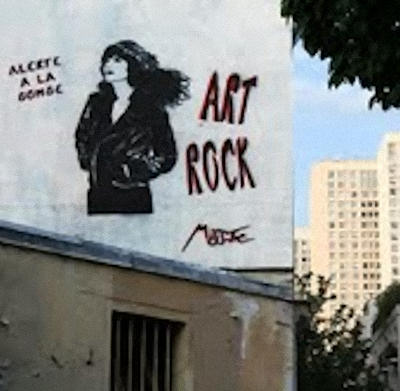
Courtesy of Miss.Tic
"The wall is the territory of my poems. It is my publisher."
Thus declared Miss.Tic, the Parisian l'artíste de la rue ("Artist of the Street") back in the 1980's when she began to create her pochoirs (stenciled images) on the walls of Paris buildings, particularly those in a neighborhood called La Butte-aux-Cailles(pronounced 'La- Boot-o-Kye') where she still has her atelier.
One of the very few female street artists, this Queen of Paris Street Art was determined to make art for everyone, as she says, out on the streets unconfined to the spaces of galleries and museums. Miss.Tic's images turn female media stereotypes on their head, as they show a mesmerizing mélange of strength, spirit, sexiness and style. These women are never victims of their vulnerability even as they confront the range of demands and dilemmas Life presents. In fact, they show the many brash and brave faces of Miss.Tic herself.
If there is a common thread that all Miss.Tic's powerful female images share—it is a determination to live Life—without letting fear interfere.
Since her early years in the 80's, when she had to elude the police to put up her "art for everyone" on the building walls of Paris streets—her "sit-up-and-take-notice" images have become a dominant feature of certain of the city's streets, especially those in the neighborhood where she started, La Butte-aux-Cailles. This low-key, but off-beat quartier feels like a village separate from Paris—and in fact had been a village separate from Paris until the late nineteenth century. La Butte still retains the feel, friendliness, and plus intime quality of a village.
Miss.Tic's images have accompanying poetic phrases ranging from "Zen Koan-like" word-plays, to philosophical musings, to down-to-earth wants. As her very name suggests, Miss.Tic loves plays on words and the unexpected meanings that can result:
"Should we pray for god to exist?"
"Sorceress, gone astray in a world without magic"
Her many thought-provoking phrases catch attention, even of French academics like Nicole Asquith, who included the wall art of Miss.Tic in a paper she delivered at a heady literary conference titled, "Extreme Poetry: French Hip-Hop and Transitivity of the Verb."
"Poetry is an extreme sport"
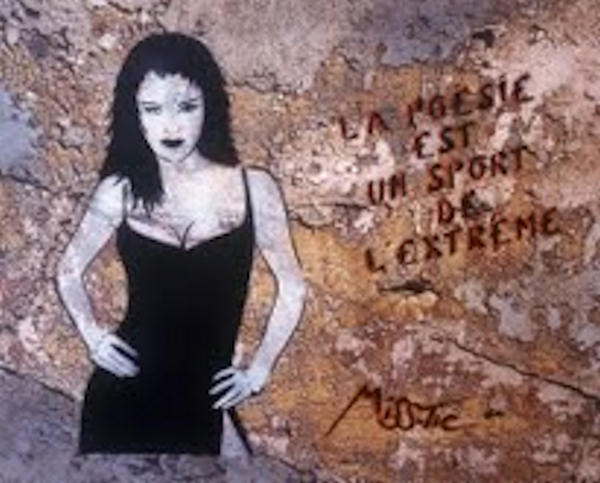
Courtesy of Miss.Tic
Another researcher, Margaret Lok wrote of the artist, "Miss.Tic combines her wall art, usually of a fetching young woman in black lingerie, with passionate feminist haiku."
Miss.Tic's art unites high and low, insisting on the body with its range of needs and wants as integral to the poetic spirit and the human equation. To quote another of her pochoir phrases:
"Woman of spirit
I give back
Body
To language."
…and another phrase, which puts the needs of spirit and body more succinctly:
"I am searching for the truth and for an apartment."
As I sat with Miss.Tic in her atelier (discreetly located behind an unassuming, street-level storefront as are many artist studios in La Butte), I asked about her initial attraction to making art of the street. Very few females have engaged in this publicly rebellious, and legally risky form of art (lest we forget—it is relatively recent in human history that women have been encouraged, indeed even permitted to pursue art—as it was long thought to be "morally harmful" for females to see nude models in a life drawing class!)
Miss.Tic says, "That I am one of the few females doing street art is a question of history and culture. I am attracted to the form because I believe art should be open and for all, and not only behind closed doors in museums and galleries. Art should be on the streets, open and accessible to everyone."
She believes the presence of art creates a culture of intelligence. "Art is harmful to stupidity," as one of her pochoir phrases goes.
It was fitting that Miss.Tic began her "art for everyone" in La Butte-aux-Cailles —as, historically, the quartier was one of the last hold-outs of the 19th century Paris Commune (An office devoted to the history of the Paris Commune is still in La Butte, sharing one of its main streets with many Miss.Tic radical, one-of-a kind wall images).
Later in its history, La Butte was the site for low-cost housing for working artisans, leather and iron workers, who traditionally populated the area. In the 80's a wave of wall artists took to the streets of working class districts.
Along with other street artists in Paris, Miss.Tic was part of a 1980's movement where the walls of Paris buildings became artists' "canvases"—especially in the streets of districts housing the working class and dispossessed. Through the 80's and 90's, street artists spent many a night eluding the police and risking arrest and fines of many thousands of francs.
Miss.Tic came to make her peace with the city's powers-that-be, especially in La Butte-aux Cailles —where her vision prevails. A savvy strategizer, she won over politicians on both the left and the right who began to respect her and her work. Now "legal", she has brought much positive attention and more visitors to the quartier.
The artist's success does not surprise her. When I ask Miss.Tic, "When you first started making your art, did you ever imagine your artistic vision would come to dominate an entire quartier in Paris?" she answers without skipping a beat.
"Mais oui, bien sur!," ("Why yes, but of course!") she answers, and then adds "I expected it to happen!" (one does wrong to expect modesty from Miss.Tic—whose work is not about modesty but about taking life — with its kaleidoscope of desires and disappointments — at full throttle). She acknowledges that she took a great risk by stenciling on public walls—and her early critics maligned her for "making the public walls of Paris her personal canvas".
Now Miss.Tic's images are not only in the streets of Paris but also in some of its top galleries around Saint-Germain (this summer at the Gallerie Lelia Mordoch on Rue Mazzarine), where one of her stenciled works can fetch 12,000 euros and up. Her work has also been exhibited at world-class venues championing modern and post-modern art, such as the Pompidou Center in Paris, the Victoria and Albert Museum in London. Her unique and recognizable images have even made it onto a series of French postages stamps.
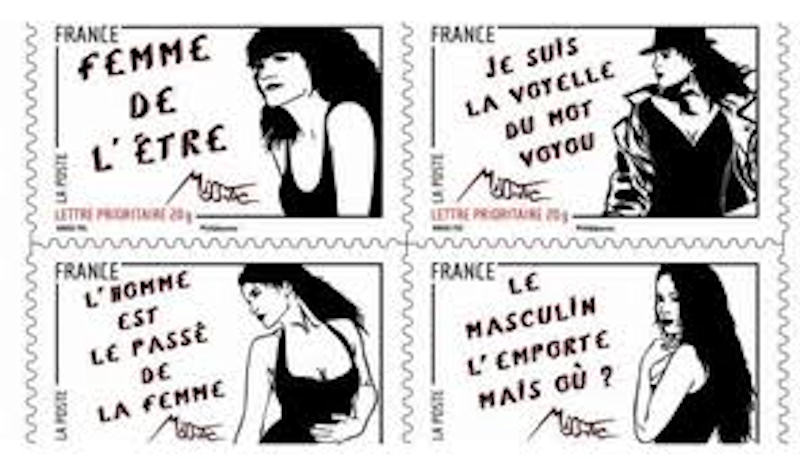
Courtesy of Miss.Tic
It's been said there is passionate feminism in Miss.Tic's work—indeed some say "post-feminism". Her art shows a woman who owns the unpredictable winds of eros as she owns her creativity. Miss.Tic is never 'politically correct'.
"I have slept with an army of feelings," writes Miss.Tic in one of her pochoirs.
Her self-knowledge has come at a high price: having to confront unspeakable personal tragedies at a tender age. If one of her themes is the inevitability of eros, the other is the inevitability of life's fragility.
Miss.Tic lost nearly her entire family in a car accident at the age of 8. Then at age 16, she lost her father to a heart attack.
It was after those tragic events that she took to the streets, determined to put what some have have called her autobiography—in images and poetic phrases—on the streets of Paris.
Many of the lines express the temporary nature of all of Life:
"Serial time is an illusion."
And another: "Time—is it the perfect crime?"
One feels it is this gut knowledge of life's fragility that inspires her refusal to let fear interfere.
I ask Miss.Tic if she identifies with radical French poets of the past, those whose similarly put a radical new stamp on the culture. "Oui!" she says without any hesitation. "Ushering in the new is part of my culture, part of my heritage, part of me. I cannot do otherwise than to be part of it." In some ways Miss.Tic strikes me as Rimbaud's the woman of the future.
"Poetry is my medicine," she adds. "If I am sick—physically or emotionally—poetry is what I take to cure myself.
Asked what she thinks of American artists of the streets such as Keith Haring and Jean-Michel Basquiat, Miss.Tic says, "The Americans are ahead of us in art of the street. They were able to appreciate its power and accepted its vision much earlier. The American mind is more open to new forms than the French one."
As the world more and more accepts the vision of an open art and poetry for all—Miss.Tic's work will continue to be exhibited around the world. But it all started in a unique Paris quartier, La Butte-aux-Cailles.
When will we see Miss.Tic in New York?
When I tell Miss.Tic I live in New York's 'Chelsea', she says her dream is to see her work there. It would not be surprising to see Miss.Tic in New York—a city that has always particularly welcomed those with a refusal to let fear interfere.
To quote Miss.Tic, still lover of Life with all its risks and dangers, "Been through it all…and still back for more."
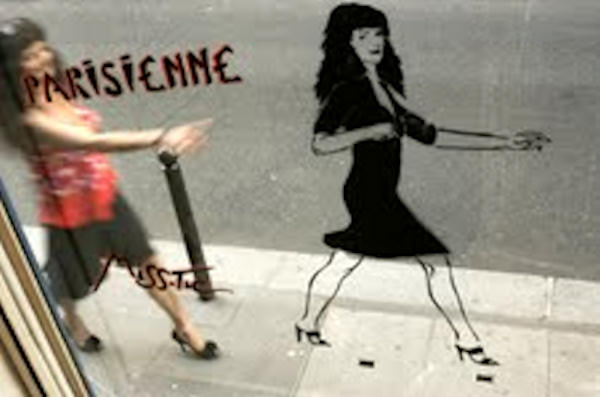
Courtesy of Miss.Tic
Why oh why in La Butte-aux-Cailles?
How "wall art" came to dominate the quartier's streetscapes
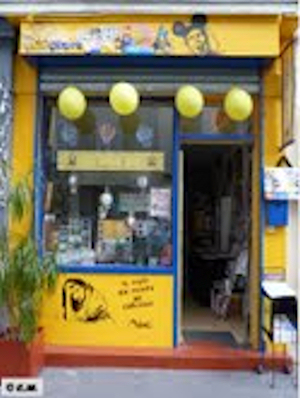
Copyright E.M.
http://www.paris-mythique.fr/
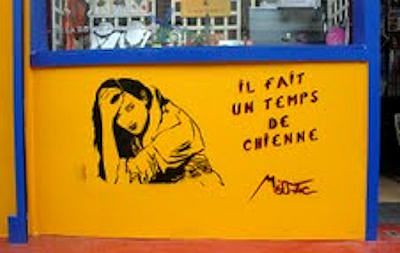
Courtesy of Miss.Tic
According to to Jean-François, owner of Paris-Mythique, a shop that offers souvenirs and memorabilia of La Butte-aux-Cailles, the area has certain intriguing aspects, in both its Intime-nightlife and history. "Some features of La Butte-aux-Cailles are already well-known: its street art, its good restaurants and cafés at good prices, its street art. But there are some historic features that need to be better known—La Butte-aux-Cailles was not only the last hold-out of the 19th century Paris commune, but also the place where the first human flight (in a hot air balloon) took place. There is a wonderful, colorful artist's image celebrating this event on the wall of a discreet courtyard in La Butte-aux-Cailles. A stone monument commemorating the event is in the main square, Place Paul Verlaine (named for the poet). The square also hosts an artesian well to which local residents bring receptacles and collect pure spring water. The same spring water is also pumped into La Butte's public pool, one of the first in Paris and also famous for its art deco style. And the River Bièvre, now underground, once flowed through the area."
Hmmm…the first human flight, the underground river, the artesian spring — water and sky — two key features of La Butte-aux-Cailles history —are also those that sustain Life and Dreams, body and spirit. Exactly the marriage of elements, come to think of it, found in the art of Miss.Tic.
The lessons of Miss.Tic lead the way through this Paris Quartier
To tour the two main streets of La Butte-aux-Cailles is to be guided by Miss.Tic's wall art works, serving as the quartier's 'GPS'. Standing just in front of the quartier's major meeting place, the bar-café, Le Diamant (at the intersection of Rue de la Butte-aux-Cailles and Rue des Cinq Diamants), there is a Miss.Tic pochoir, peering at us from a large white space saying, "Even stronger than desire is illusion."
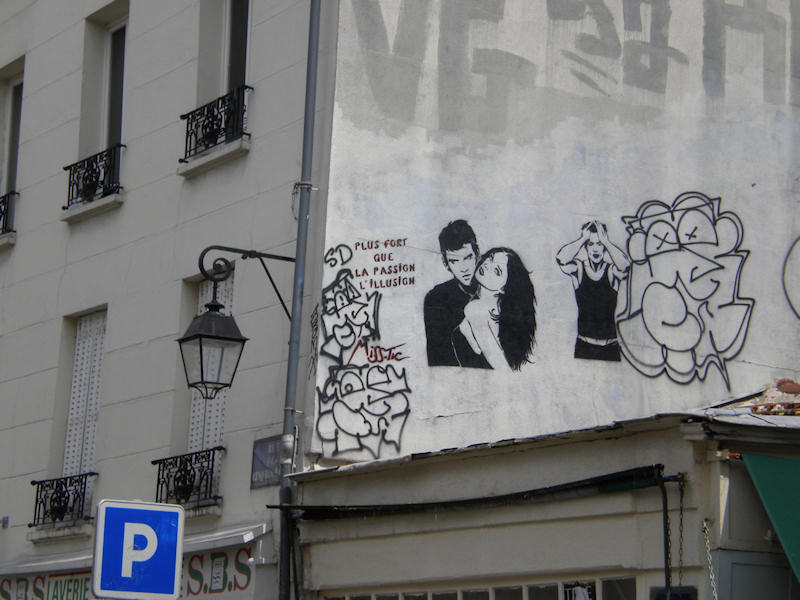
Photo by P.L. Duffy
Just a few doors down the street at Chez Mamane, where friendly Monsieur Mamane has been making perfect couscous dishes for 40 years, one sees a large and sexy Miss.Tic pochoir on the restaurant's back wall saying to a male companion, "If you tell me of your thirst, will it slake mine?"
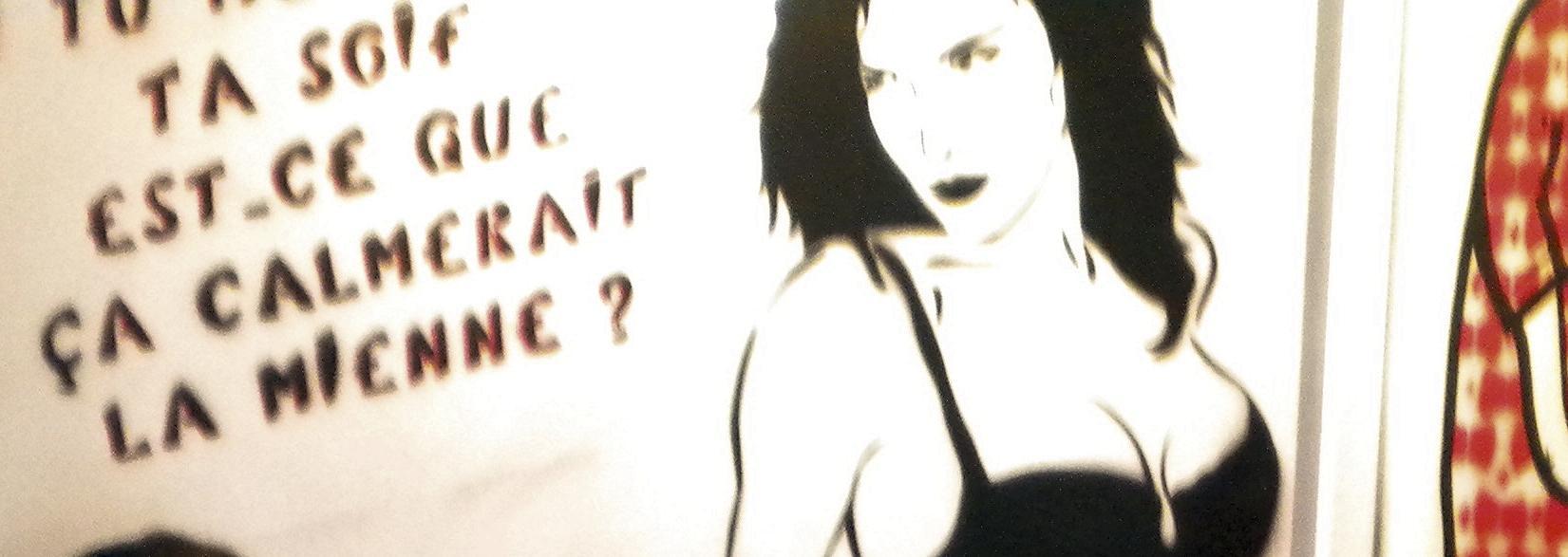
Photo by P.L. Duffy
Then just down two doors at the corner of the street we find ourselves at at Au Passage des Artists (where you can get the most amazing mussels and frites), we see Miss.Tic just outside the door welcoming us with "Serial time is an illusion".
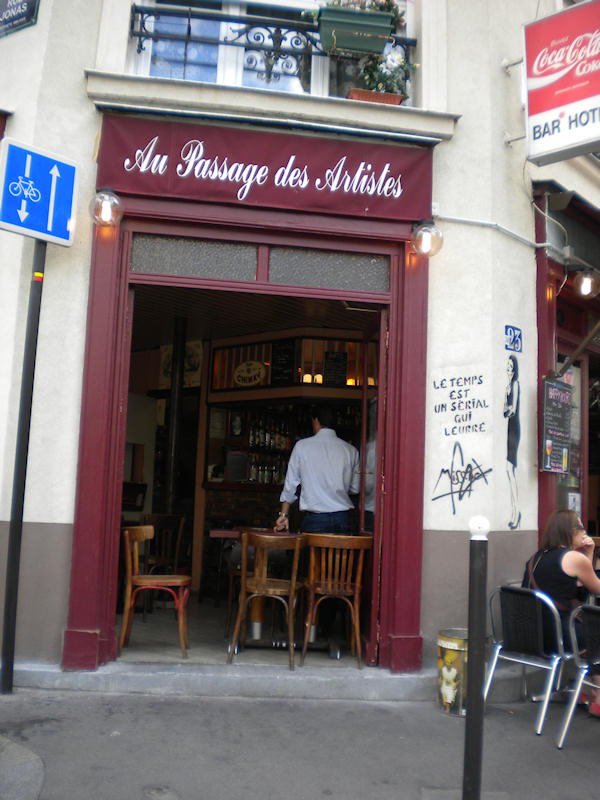
Photo by P.L. Duffy
Around the corner and up a bit to the corner of Rue de la Butte-aux-Cailles and Rue Samson, Miss.Tic, looks squarely at us from an outside panel of the Auberge de la Butte, ever mindful of the needs of the body along with those of the spirit, saying, "I am searching for the truth and for an apartment."
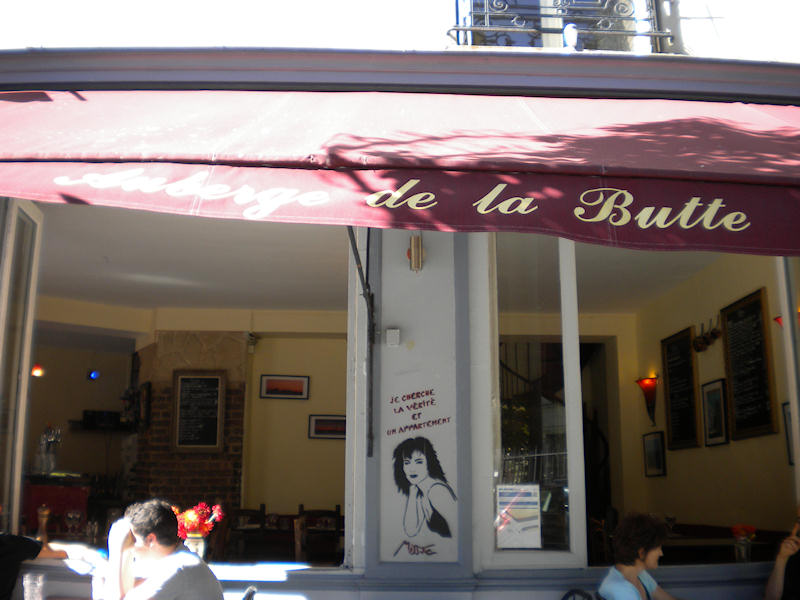
Photo by P.L. Duffy
P.S. …and all the way down Rue de La Butte-aux-Cailles to the Rue de l'Espérance, as we have a nice seat on the terrace of A La Bonne Cave, we can discover some other street artists of the area on the stone wall just opposite us: Jeff Aerosol and his flying men play patty-cake with a star-burst:
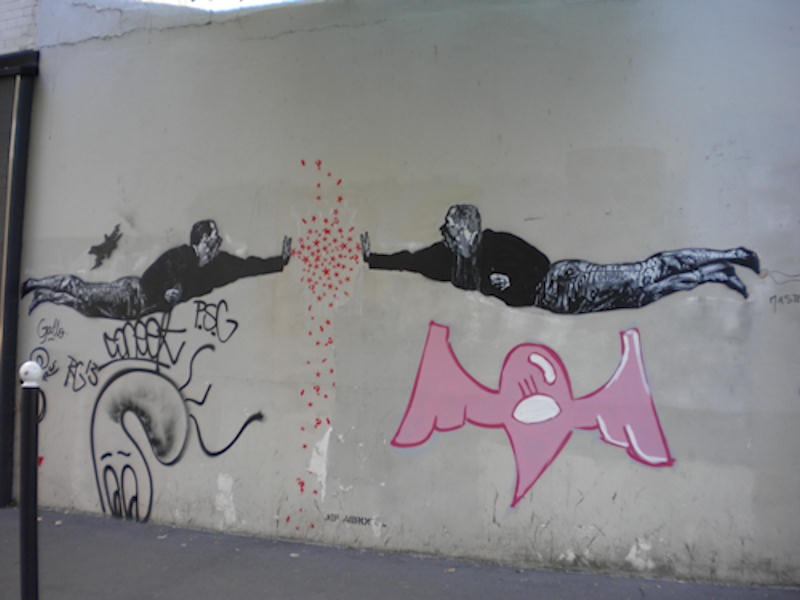
Photo by P.L. Duffy
Patricia Lynne Duffy is a writer living in New York City. She is the author of a book on creativity and synesthesia, Blue Cats and Chartreuse Kittens: How synesthetes color their worlds (Henry Holt 2001), plus a chapter contributer to the forthcoming Oxford University Press Handbook on Synesthesia. Her shorter pieces include two award-winning essays, Dining in French and Taipei Tales.